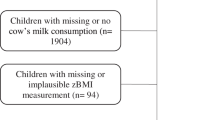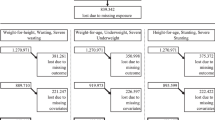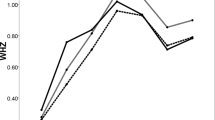Abstract
Purpose
The literature is inconsistent regarding milk intake and physical growth. This study aims to evaluate the association of milk intake with body height and weight in a nationally representative sample of Chinese children.
Methods
A total of 41,439 children ages 6–17 were recruited from 30 provinces in mainland China in 2013–2016 using a multistage stratified cluster sampling approach. Milk intake information was collected using a questionnaire aided with standard containers. Weight and height were measured using a standard physician beam scale with a height rod. Milk intake was categorized into no-, low-, and high-intake groups based on the intake rate, and weight status into normal, overweight, and obese groups based on the body-mass-index (BMI). Associations between height/weight status and milk intake were evaluated using multivariate weighted linear and logistic regression models.
Results
Chinese children had low milk intake: 1/5 of children did not drink milk, and those drinking milk had a median intake of 100 ml/month. The low- and high-intake groups were 0.83 cm (95% confidence interval: 0.00, 1.68 cm) and 1.26 cm (0.34, 2.19 cm) taller than the no-intake group for girls, respectively, after adjusting for confounding factors. Boys with high milk intake had lower BMI (−0.56, 95% CI: −1.00, −0.12 kg/m2) and risk of obesity (OR = 0.67, 95% CI: 0.46, 0.97) than those without milk intake.
Conclusions
This study revealed the association of increased milk intake with increased body height and lowered obesity risk among Chinese children. Given the cross-sectional nature of the study and the possibility of residual confounding, further research is warranted to uncover the role of milk intake in promoting children’s growth.
This is a preview of subscription content, access via your institution
Access options
Subscribe to this journal
Receive 12 print issues and online access
$259.00 per year
only $21.58 per issue
Buy this article
- Purchase on Springer Link
- Instant access to full article PDF
Prices may be subject to local taxes which are calculated during checkout
Similar content being viewed by others
References
Waterlow JC, Buzina R, Keller W, Lane JM, Nichaman MZ, Tanner JM. The presentation and use of height and weight data for comparing the nutritional status of groups of children under the age of 10 years. Bull World Health Organ. 1977;55:489–98.
Wiley AS. Dairy and milk consumption and child growth: is BMI involved? An analysis of NHANES 1999-2004. Am J Hum Biol. 2010;22:517–25.
Walter CW, David SL. Milk and health. NEJM. 2020;382:644–54.
Shi X. Chinese dietary guidelines 2016. Chin J Woman Child Health Res. 2016;27:30.
Association CHIEP. Chinese drinking habits survey report 2017. Royal Dutch Friesland and Godmother Parenting Network: Beijing, China, 2017.
Sun H, Ma Y, Han D, Pan CW, Xu Y. Prevalence and trends in obesity among China’s children and adolescents, 1985–2010. Plos ONE. 2014;9:e105469.
Foundation CCAT. Research report on the status quo of Chinese children's height management. China Children and Teenagers: Beijing, China, 2017.
De Beer H. Dairy products and physical stature: a systematic review and meta-analysis of controlled trials. Econ Hum Biol. 2012;10:299–309.
Holmes MD, Pollack MN, Willett WC, Hankinson SE. Dietary correlates of plasma insulin-like growth factor 1 and insulin-like growth factor binding protein 3 concentrations. Cancer Epidemiol Biomark Prev. 2002;11:862–7.
Kim SH, Kim WK, Kang MH. Effect of milk and milk products consumption on physical growth and bone mineral density in Korean adolescents. Nutr Res Pract. 2013;7:309–14.
Marshall TA, Curtis AM, Cavanaugh JE, Warren JJ, Levy SM. Higher longitudinal milk intakes are associated with increased height in a birth cohort followed for 17 years. J Nutr. 2018;148:1144–9.
Lu L, Xun P, Wan Y, He K, Cai W. Long-term association between dairy consumption and risk of childhood obesity: a systematic review and meta-analysis of prospective cohort studies. Eur J Clin Nutr. 2016;70:414–23.
Huh SY, Rifasshiman SL, Richedwards JW, Taveras EM, Gillman MW. Prospective association between milk intake and adiposity in preschool-aged children. J Am Diet Assoc. 2010;110:563–70.
Beck AL, Heyman M, Chao C, Wojcicki J. Full fat milk consumption protects against severe childhood obesity in Latinos. Prev Med Rep. 2017;8:1–5.
Abreu S, Santos R, Moreira C, Santos PC, Vale S, Soaresmiranda L, et al. Milk intake is inversely related to body mass index and body fat in girls. Eur J Pediatr. 2012;171:1467–74.
Abreu S, Santos R, Moreira C, Vale S, Santos PC, Soares-Miranda L, et al. Association between dairy product intake and abdominal obesity in Azorean adolescents. Eur J Clin Nutr. 2012;66:830–5.
Dougkas A, Reynolds CK, Givens ID, Elwood PC, Minihane AM. Associations between dairy consumption and body weight: a review of the evidence and underlying mechanisms. Nutr Res Rev. 2011;24:72–95.
Major GC, J PC, Ledoux M, St-Pierre S, Anderson GH, Zemel MB, et al. Recent developments in calcium-related obesity research. Obesity Rev. 2010;9:428–45.
Yuangklang C, Wensing T, Van dBL, Jittakhot S, Beynen AC. Fat digestion in veal calves fed milk replacers low or high in calcium and containing either casein or soy protein isolate. J Dairy Sci. 2004;87:1051–6.
Jacobsen R, Lorenzen JK, Toubro S, Krogmikkelsen I, Astrup AJ. Effect of short-term high dietary calcium intake on 24-h energy expenditure, fat oxidation, and fecal fat excretion. Int J Obes. 2004;29:292–301.
Wiley AS. Dairy and milk consumption and child growth: is BMI involved? An analysis of NHANES 1999–2004. Am J Hum Biol. 2010;22:517–25.
Deboer MD, Agard HE, Scharf RJ. Milk intake, height and body mass index in preschool children. Arch Dis Child. 2015;100:460–5.
Phillips SM, Bandini LG, Cyr H, Colcloughdouglas S, Naumova E, Must A. Dairy food consumption and body weight and fatness studied longitudinally over the adolescent period. Int J Obes Relat Metab Disord. 2003;27:1106–13.
Fayet F, Ridges LA, Wright JK, Petocz P. Australian children who drink milk (plain or flavored) have higher milk and micronutrient intakes but similar body mass index to those who do not drink milk. Nutr Res. 2013;33:95–102.
Bergholdt HK, Nordestgaard BG, Ellervik C. Milk intake is not associated with low risk of diabetes or overweight-obesity: a Mendelian randomization study in 97,811 Danish individuals. Am J Clin Nutr. 2015;102:487–96.
Shi LL, Tarrant M, Lai LH, Man KK, Tai HL, Leung GM, et al. The role of dairy products and milk in adolescent obesity: evidence from Hong Kong’s “Children of 1997” birth cohort. Plos ONE. 2012;7:e52575.
Ww DU, Zhang B, Wang HJ, Wang ZH, Su C. Milk consumption and effects on dietary nutrients and growth status among Chinese children in nine provinces (autonomous region) from 1991 to 2006. Zhonghua Yu Fang Yi Xue Za Zhi. 2011;45:313–7.
Guo Q, Wang B, Cao S, Jia C, Zhao L, Zhang Q, et al. Patterns and sociodemographic determinants of water intake by children in China: results from the first national population-based survey. Eur J Nutr. 2019. https://doi.org/10.1007/s00394-019-01921-w.
Zheng CJ, Duan XL, Wang ZS, Wang BB, Huang N, Cao SZ. Drinking water exposure factors among residents in Biyang area in winter. J Environ Health. 2013;30:226–9.
Li H, Zong XN, Ji CY, Mi J. Body mass index cut-offs for overweight and obesity in Chinese children and adolescents aged 2–18 years. Zhonghua Liu Xing Bing Xue Za Zhi. 2010;31:616–20.
Leung SSF. Establishing a standard definition for child overweight and obesity worldwide. BMJ. 2015;320:1240.
Kuczmarski RJ, Ogden CL, Guo SS, Grummer-Strawn LM, Flegal KM, Mei Z, et al. 2000 CDC growth charts for the United States: methods and development. Vital Health Stat. 2002;246:1–190.
De OM, Onyango AW, Borghi E, Siyam A, Nishida C, Siekmann J. Development of a WHO growth reference for school-aged children and adolescents. Bull World Health Organ. 2007;85:660.
Rosner B. Fundamentals of biostatistics. Am Stat. 2011;61:183.
Lumley T. Complex surveys: a guide to analysis using R. John Wiley and Sons: Hoboken, New Jersey, 2010.
Black RE, Williams SM, Jones IE, Ailsa GJ. Children who avoid drinking cow milk have low dietary calcium intakes and poor bone health. Am J Clin Nutr. 2002;76:675–80.
Du X, Zhu K, Trube A, Zhang Q, Ma G, Hu X, et al. School-milk intervention trial enhances growth and bone mineral accretion in Chinese girls aged 10–12 years in Beijing. Br J Nutr. 2004;92:159–68.
Berkey CS, Colditz GA, Rockett HR, Frazier AL, Willett WC. Dairy consumption and female height growth: prospective cohort study. Cancer Epidemiol Biomark Prev. 2009;18:1881–7.
Zhang L, Tong R, Zhang X. Study on the effect of drinking fortified milk on the development of adolescent girls. Chin Sch Health. 2006;27:611–2.
Fiorito LM, Ventura AK, Mitchell DC, Smiciklas-Wright H, Birch LL. Girls’ dairy intake, energy intake, and weight status. J Am Diet Assoc. 2006;106:1851–5.
Barba G, Troiano E, Russo P, Venezia A, Siani A. Inverse association between body mass and frequency of milk consumption in children. Br J Nutr. 2005;93:15–9.
Tam CS, Garnett SP, Cowell CT, Campbell K, Cabrera G, Baur LA. Soft drink consumption and excess weight gain in Australian school students: results from the Nepean study. Int J Obes. 2006;30:1091–3.
Merrilees MJ, Smart EJ, Gilchrist NL, Frampton C, Turner JG, Hooke E, et al. Effects of dairy food supplements on bone mineral density in teenage girls. Eur J Nutr. 2000;39:256–62.
Danyliw AD, Vatanparast H, Nikpartow N, Whiting SJ. Beverage patterns among Canadian children and relationship to overweight and obesity. Appl Physiol Nutr Metab. 2012;37:900–6.
Champagne CM, Baker NB, Delany JP, Harsha DW, Bray GA. Assessment of energy intake underreporting by doubly labeled water and observations on reported nutrient intakes in children. J Am Diet Assoc. 1998;98:426–33.
Huang TT, Roberts SB, Howarth NC, Mccrory MA. Effect of screening out implausible energy intake reports on relationships between diet and BMI. Obesity. 2012;13:1205–17.
Huang TT, Howarth NC, Lin BH, Roberts SB, Mccrory MA. Energy intake and meal portions: associations with BMI percentile in U.S. children. Obesity. 2012;12:1875–85.
Hebert JR, Clemow L, Pbert L, Ockene IS, Ockene JK. Social desirability bias in dietary self-report may compromise the validity of dietary intake measures. Int J Epidemiol. 1995;24:389–98.
Klesges LM, Baranowski T, Beech B, Cullen K, Murray DM, Rochon J, et al. Social desirability bias in self-reported dietary, physical activity and weight concerns measures in 8- to 10-year-old African-American girls: results from the Girls Health Enrichment Multisite Studies (GEMS). Prev Med. 2004;38:S78–87.
Hébert JR, Peterson KE, Hurley TG, Stoddard AM, Cohen N, Field AE, et al. The effect of social desirability trait on self-reported dietary measures among multi-ethnic female health center employees. Ann Epidemiol. 2001;11:417–27.
Vaskonen T. Dietary minerals and modification of cardiovascular risk factors. J Nutr Biochem. 2003;14:492–506.
Astrup A, Chaput JP, Gilbert JA, Lorenzen JK. Dairy beverages and energy balance. Physiol Behav. 2010;100:67–75.
Wiley AS. Does milk make children grow? Relationships between milk consumption and height in NHANES 1999-2002. Am J Hum Biol. 2005;17:425–41.
Zhao X, Yin S. Research progress on lactose intolerance and solutions. Chin J Sch Health. 2007;28:1151–3.
Zhao L. Monitoring report on nutrition and health status of Chinese residents 2010–2013. People’s Health Publishing House: Beijing, China, 2018.
Welsman J, Armstrong N. Physical activity patterns in secondary school children. Eur J Phys Educ. 2006;5:147–57.
Song C, Guo H, Gong W, Zhang Y, Ding C, Feng G. et al.Status of sedentary activities in the leisure time in Chinese pupils in 2010–2012. J Hyg Res. 2017;46:705–8.
Diggle P, Heagerty P, Liang KY, Zeger S. Analysis of longitudinal data. Oxford Press: Oxford, United Kingdom, 2002.
Acknowledgements
This study was funded by the Ministry of Ecology and Environment of China (E.H. 2013-09-01) and the Chinese Academy of Engineering (2017-ZD-05-02-02). We also thank Guansheng Ma of Peking University for his help with research ideas. The authors express their sincere gratitude to all the participating children and parents for their cooperation.
Author information
Authors and Affiliations
Corresponding author
Ethics declarations
Conflict of interest
The authors declare that they have no conflict of interest.
Additional information
Publisher’s note Springer Nature remains neutral with regard to jurisdictional claims in published maps and institutional affiliations.
Supplementary information
Rights and permissions
About this article
Cite this article
Guo, Q., Wang, B., Cao, S. et al. Association between milk intake and childhood growth: results from a nationwide cross-sectional survey. Int J Obes 44, 2194–2202 (2020). https://doi.org/10.1038/s41366-020-0625-4
Received:
Revised:
Accepted:
Published:
Issue Date:
DOI: https://doi.org/10.1038/s41366-020-0625-4
This article is cited by
-
Milk and dairy consumption is positively associated with height in adolescents: results from the Israeli National Youth Health and Nutrition Survey
European Journal of Nutrition (2022)
-
The relationship between dietary patterns and overweight and obesity among adult in Jiangsu Province of China: a structural equation model
BMC Public Health (2021)



